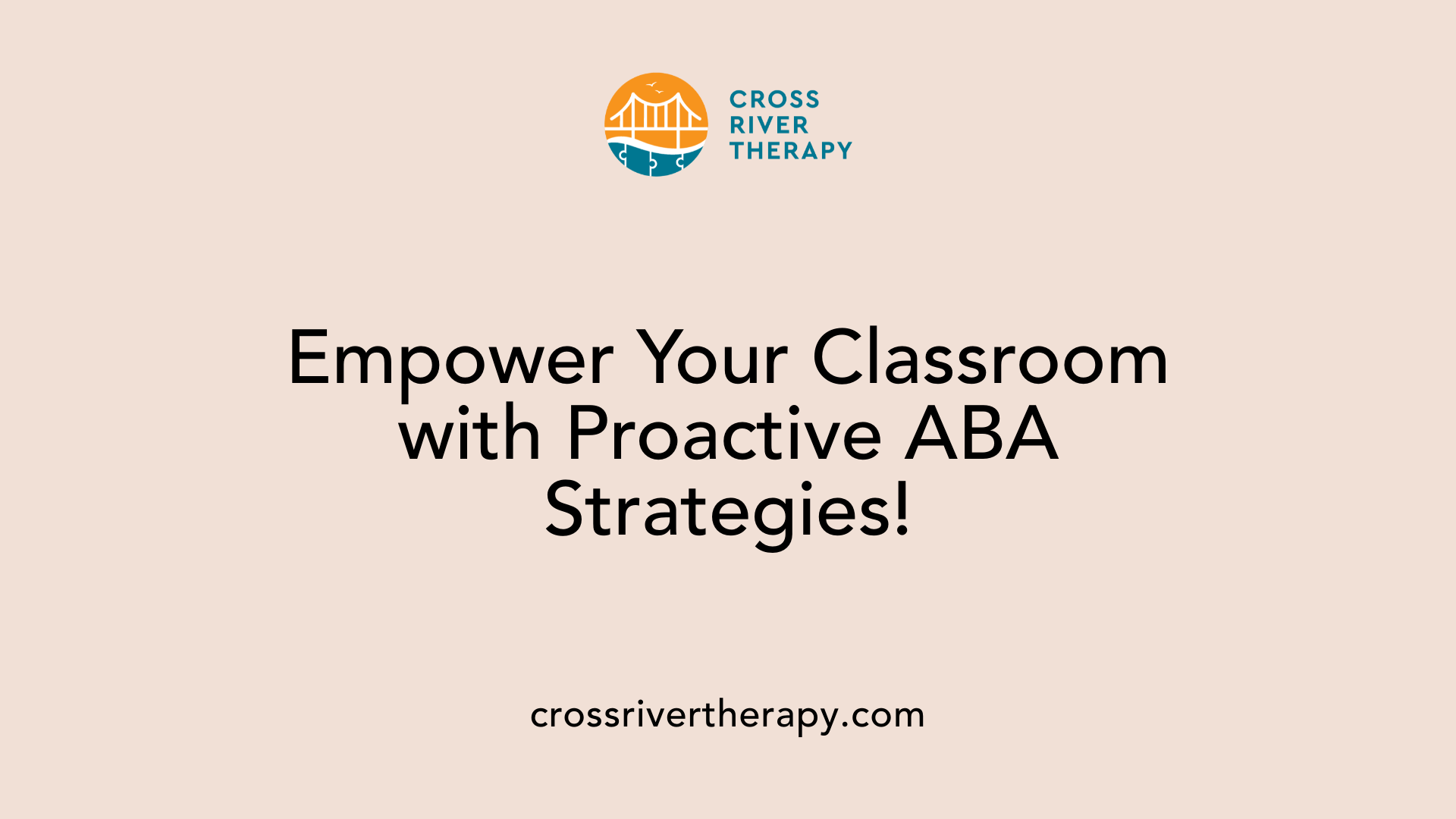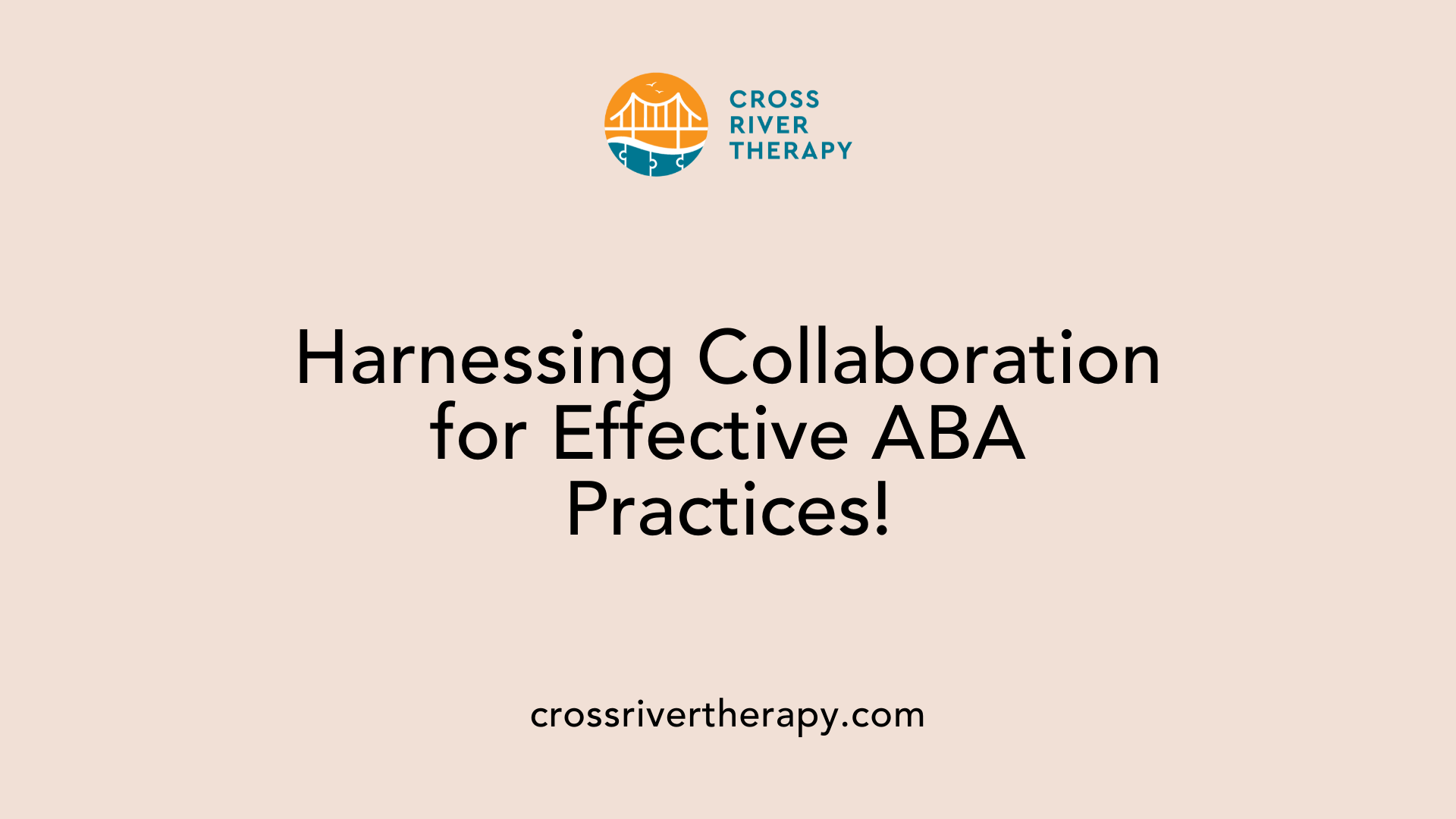How Teachers Can Collaborate with ABA Therapists in Schools
Building Bridges Between Teachers and ABA Therapists
Introduction
As the role of schools in fostering inclusive environments grows, so does the importance of collaboration between teachers and ABA therapists. Recognizing the expertise that each brings to the table, effective collaboration becomes a cornerstone in supporting students with autism and other developmental disabilities. Understanding how to work together seamlessly can profoundly impact educational outcomes by ensuring that interventions are both consistent and customized to student needs.
Establishing Effective Collaboration

How can teachers and behavior specialists collaborate effectively?
Collaboration between teachers and behavior specialists hinges on a foundation of trust and respect. Both parties must feel valued in the process to achieve meaningful outcomes for students. This involves establishing respectful communication and regularly scheduled planning meetings.
These intensive meetings should focus not only on analyzing student needs but also on discussing observational data collected in the classroom. This empowers teachers to use insights drawn from the data to adapt interventions that might be applied to their unique classroom contexts.
Integrating behavior specialists into the school's overall support system further fosters a sense of agency among teachers. They can take ownership of behavioral strategies that resonate within their classrooms, making the application more natural and effective.
Building trust and respect
Building trust requires actively engaging teachers in decision-making processes related to behavioral interventions. Facilitating open discussions around concepts like "Voice, Choice, and Ownership" can significantly enhance their engagement and influence.
Framework for collaboration
A structured framework that outlines roles and responsibilities helps prevent misunderstandings and promotes clarity. Clear definitions help establish boundaries for implementing behavior plans and IEP goals, ensuring everyone is aligned toward common objectives.
Role of planning in collaboration
Consistent check-ins on implementation progress support collaborative efforts. Regular communication allows for necessary adjustments in strategies, ensuring they remain effective in meeting each student's needs. This collective, data-informed approach ultimately nurtures a collaborative environment where students can thrive.
Proactive ABA Methods for the Classroom

What are proactive ABA methods that teachers can use in the classroom?
Proactive ABA methods are essential tools for teachers looking to enhance student engagement and behavior management in the classroom. By creating clear routines, teachers provide students with a structured framework, which can significantly reduce instances of misbehavior. Allowing students ample practice time to understand these expectations builds their confidence and competence.
Incorporating regular brain breaks is another beneficial strategy, especially for students with attention difficulties. These breaks help students refocus and alleviate fatigue, maximizing their learning potential.
Additionally, utilizing visual strategies can further enhance comprehension and engagement. Tools like token boards or multimedia presentations offer visual cues that support verbal instructions, catering to different learning styles.
How can individualized teaching approaches be integrated?
Adapting teaching approaches to meet individual student needs is crucial. For instance, permitting short stretching or snack breaks can help maintain alertness and minimize distractions during lessons.
Using silent signals for behavior management encourages non-verbal communication, which can be less disruptive and more effective in maintaining attention. Moreover, the application of positive reinforcement strategies enables teachers to foster a supportive and encouraging learning environment, further minimizing disruptive behaviors.
Overview of proactive ABA methods
| Method | Description | Benefits |
|---|---|---|
| Clear Routines | Establishing predictable classroom procedures | Reduces misbehavior and uncertainty |
| Regular Brain Breaks | Scheduled short breaks for refocusing | Enhances attention |
| Visual Strategies | Tools like token boards for non-verbal cues | Boosts engagement and understanding |
| Individualized Approaches | Customizing lessons to suit student needs (e.g., snack breaks) | Improves alertness and focus |
| Silent Signals for Behavior | Non-verbal cues to manage classroom behavior | Less disruptive communication |
| Positive Reinforcement | Recognizing and rewarding desired behaviors | Creates a supportive environment |
Implementing these proactive ABA methods can create a more effective and responsive classroom, ultimately promoting a positive learning experience for all students.
The Importance of Collaboration in ABA

Why is collaboration important in ABA?
Collaboration is a fundamental component in the field of Applied Behavior Analysis (ABA), especially when addressing the needs of students with diverse learning requirements. Engaging multiple stakeholders—like Board-Certified Behavior Analysts (BCBAs), ABA therapists, teachers, and families—creates a robust framework that supports the development of effective treatment plans tailored to individual needs.
When professionals collaborate, they share their unique skills and insights. For instance, a BCBA may understand the technical aspects of behavior modification, while teachers possess in-depth knowledge of their students’ academic environments. This synergy ensures that strategies such as the use of discriminative stimuli, verbal prompts, and visual supports are integrated effectively into both therapy sessions and classroom routines.
Team contributions in ABA
A successful collaborative effort is built on the contributions of each team member. BCBAs might lead the planning of behavior intervention plans and engage with teachers to provide ongoing training on behavior management. At the same time, educators share information about students’ progress and classroom dynamics, which is crucial for adjusting strategies that cater to the changing needs of the child.
Consistent communication between these professionals and families enhances the effectiveness of interventions. Regular updates, shared goals, and insights into the child’s behavior at home and school create a cohesive understanding of the student’s development.
Integration of skills and perspectives
Integrating diverse perspectives is vital in crafting well-rounded strategies. Effective collaboration fosters a culture of trust and respect, allowing for open dialogues that lead to innovative solutions for challenges faced in the classroom and therapy sessions. Parents, too, play a crucial role by sharing valuable insights regarding their child's preferences and behavior at home, reinforcing the importance of a unified approach.
Consistency in strategy implementation
Finally, consistency is key in ensuring that behavioral strategies are effectively implemented across different settings. Fortifying the connection between home and school environments through shared techniques and regular communication can significantly enhance behavioral outcomes for the child.
Thus, fostering collaboration among all parties involved in a child's education not only enhances the effectiveness of ABA interventions but also creates a supportive environment conducive to learning and development.
Strategies for Teacher Collaboration

What strategies can teachers use to collaborate with each other?
To build effective collaboration among teachers, several strategies can be employed:
- Create a Shared Vision and Goals: Formulating common goals fosters ownership and investment among educators, encouraging collaborative efforts.
- Develop a Sense of Community: Promoting respect, understanding, and trust is essential in building a supportive environment for collaboration. A strong community enhances sharing and teamwork.
- Establish Group Norms: Identifying norms can create a safe environment, where teachers feel comfortable addressing discomfort and stress.
- Utilize Discussion and Dialogue: Engaging in discussions to build consensus, alongside dialogue to explore diverse perspectives, is vital for effective outcomes.
- Acknowledge Potential Conflicts: Recognizing that conflicts may arise, it's important to establish a conflict management plan. This prepares educators to reflect on challenges and support professional growth.
Shared Vision and Goals
Creating a shared mission within collaborative teams allows teachers to align their practices and expectations. When goals are unified, efforts can multiply, leading to improved student outcomes.
Managing Conflict in Collaboration
Conflict management is crucial in inter-teacher collaborations. Teachers should be trained to navigate disagreements constructively, turning challenges into opportunities for reflection and growth. Regular check-ins and feedback loops can help preempt conflicts before they escalate.
Overcoming Challenges in Collaboration

Common Collaboration Challenges
Collaboration between teachers, behavior analysts, and other specialists can face several hurdles. Misunderstandings about roles and responsibilities are frequent, especially when the team includes professionals with varied educational backgrounds. Differences in training may lead to contrasting perspectives on student needs, causing friction.
Effective Communication and Guidelines
To overcome these obstacles, establishing clear communication channels is vital. Regular meetings should be scheduled for discussing student progress and adjusting interventions. Creating structured guidelines helps define the parameters of each professional’s role, reducing confusion and fostering a team approach. Open dialogue not only builds trust but also encourages the sharing of vital insights that inform strategies and interventions.
Adapting to Differences in Training and Roles
Recognizing the unique training of each team member is essential for effective collaboration. Psychological flexibility is important; BCBAs and other professionals need to adapt their strategies based on feedback from teachers. This approach nurtures collaborative relationships and enhances the shared goal of improving student outcomes. Additionally, soft skills such as empathy and conflict resolution play a crucial role in navigating differences, making it easier to find common ground and develop effective educational strategies.
| Challenge | Solution | Outcome |
|---|---|---|
| Role Misunderstandings | Clear definition of roles | Improved team dynamics |
| Differing Training Perspectives | Open dialogue and flexibility | Enhanced collaboration |
| Communication Barriers | Regular scheduled meetings | Better student outcomes |
Building Open Lines of Communication
Importance of communication in collaboration
Effective collaboration hinges on open lines of communication between teachers and other professionals such as behavior analysts and occupational therapists. With teachers managing large classrooms and limited preparation time, respectful scheduling of meetings is imperative. By being mindful of their schedules and workload, professionals improve the likelihood of productive discussions aimed at enhancing student outcomes.
Sharing updates and strategies
Regular sharing of updates, observations, and strategies fosters a stronger partnership. Professionals should not only communicate their insights but also respect teachers’ preferences for conducting classroom observations. For instance, organizing collaborative meetings at convenient times ensures valuable insights are exchanged, promoting a cohesive approach to student interventions.
Inclusion of parents in communication
Involving parents in the communication loop plays a vital role as they contribute essential insights regarding their child’s preferences and behaviors. Collaboration should encompass all stakeholders—teachers, parents, and therapists—making sure everyone is informed about goals and strategies. This holistic approach helps create continuity in behavioral interventions and enhances the overall educational experience for the child.
| Topic | Description | Key Benefits |
|---|---|---|
| Importance of communication | Establishing open communication fosters trust and respect between teachers and professionals. | Improved student outcomes through collaborative efforts and well-coordinated strategies. |
| Sharing updates and strategies | Regular updates and respectful scheduling enhance the partnership between educators and professionals. | Enhanced intervention strategies and consistency across settings in the child's education. |
| Inclusion of parents | Parents’ insights can aid in tailoring effective strategies, ensuring a well-rounded approach to student supports. | Greater continuity in behavioral interventions and strengthened relationships among all stakeholders. |
Role Clarity and Mutual Respect
Understanding Roles Between Teachers and BCBAs
Clear role definitions are crucial for effective collaboration between teachers and Board Certified Behavior Analysts (BCBAs). This clarity helps to avoid misunderstandings regarding responsibilities, especially concerning behavior IEP goals and the implementation of behavior plans. Teachers bring valuable insights about classroom dynamics and students, while BCBAs provide expertise in behavioral strategies and interventions. Establishing well-defined roles enables both parties to work together efficiently towards shared educational goals.
Respectful Integration into the Classroom
Entering a teacher's classroom with respect is vital. Professionals must recognize the effort that teachers put into creating and maintaining their classroom environments. When BCBAs conduct observations or provide support, it should be done thoughtfully to maintain the established order. Communicating with teachers about how and when to observe only enhances this partnership, ensuring that interventions do not disrupt the learning process.
Efficient Role Delegation
Role delegation should be approached collaboratively, ensuring that both teachers and BCBAs feel valued in their expertise. Professionals must communicate effectively about their observations and strategies while understanding the pressures teachers face in managing large classrooms. Regular meetings, where both educators and BCBAs can discuss progress and adjust strategies, foster a culture of respect and collaboration, leading to effective outcomes for the students.
| Aspect | Teachers | BCBAs |
|---|---|---|
| Expertise | Curriculum and student engagement | Behavioral interventions and strategies |
| Involvement | Maintain classroom dynamics | Develop and implement behavior plans |
| Communication | Share observations and needs | Provide feedback and adjust plans based on input |
| Respect | Acknowledge teacher's expertise | Support classroom goals with behavioral strategies |
| Scheduling | Plan observations around lesson times | Regular meetings to align interventions and updates |
| Role Clarity | Define responsibilities to avoid overlap | Collaborate on IEPs and behavior interventions |
| Consideration | Acknowledge teacher's workload | Adapt approaches based on classroom feedback |
Continuous Learning and Development
Professional Learning Communities
Engaging in professional learning communities (PLCs) is a powerful way for educators, behavior analysts, and other specialists to share vital insights and strategies. These collaborative environments promote ongoing discussions about best practices and effective interventions for diverse student needs. Participation in PLCs builds relationships and fosters a culture of mutual respect, thereby enhancing the quality of student support.
Ongoing Training and Skill Development
Professionals should prioritize continuous skill enhancement through workshops and training sessions. This applies equally to teachers, BCBAs, and therapists, ensuring everyone stays informed about the latest educational techniques and therapeutic approaches. Regular training helps address challenges faced in classrooms and equips the team with new ideas to implement.
Adapting to Classroom Dynamics
Understanding the specific dynamics of a classroom is crucial for professionals entering an educator's environment. Recognizing the teacher's established routines and the relationship they have with their students demonstrates respect and facilitates smoother collaboration. Each classroom is unique, and adapting one's strategies accordingly leads to better outcomes.
Conclusion
Effective collaboration between teachers and ABA therapists hinges on respect, communication, and a unified commitment to student success. By leveraging each other's strengths and fostering open dialogue, they can create an environment where students thrive. The shared goal of improving educational and behavioral outcomes underscores the importance of working as a cohesive team, ensuring that students with autism and developmental disabilities receive the tailored support they need to succeed in school and beyond. In embracing collaboration, educators and therapists alike empower each other, enhancing the impact of their essential work.
References
- How To Effectively Collaborate With Teachers - Behavioral Collective
- [PDF] SUCCESSFUL COLLABORATION WITH SCHOOL PROFESSIONALS
- Building A Collaborative Relationship With Your Child's Educators
- How to Use ABA in the Classroom? - Empower therapy
- How BCBAs Can Best Collaborate with Teachers - Therapy Brands
- A Guide to Collaborating with Schools in ABA Th - The Behavior Brand
- Using Discriminative Stimulus in ABA Therapy - Circle Care Services
- 9 Proactive ABA Methods to Redirect Student Behavior
- 7 Proactive ABA Strategies to Address Challenging Behaviors



